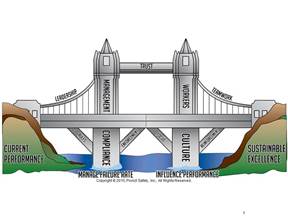A Model to Bridge the Gap from Compliance to Excellence
Trust is the glue that holds a culture of excellence together. When people don't assume agendas or hidden motives, followers will follow and groups unite.
 What visual models do you leverage to describe where you are and where you are trying to go? Are they models full of characteristics or levels of dependency? When charting your improvement course, how clear are the specific areas you need to focus on to improve the status quo?
What visual models do you leverage to describe where you are and where you are trying to go? Are they models full of characteristics or levels of dependency? When charting your improvement course, how clear are the specific areas you need to focus on to improve the status quo?
Since 2008, the Bridge to ExcellenceSM has been a visual representation many clients have licensed to convey the precise elements to be addressed to close the gap between compliance and culture and where they are on the path to sustainable excellence. Consider where you and your organization are within this model.
- Current Performance. All organizations have a current reality in their organizational systems, performance, and culture. Only those with dangerous apathy believe no further work is necessary. There will always be a better way in anything we do, and when this is the predominant mindset, we celebrate success and know there will always be improvement opportunities. How would you describe your current performance in this model?
- Sustainable Excellence. Companies that "get it" realize excellence isn't just great results. It is born from a comprehensive strategy that provides, with confidence, how the best results were obtained. It includes the realization that zero injuries, defects, or upset customers is the byproduct of excellence, and there is always room for improvement. How are you currently defining excellence, and does this help or hinder your efforts?
- Management and Compliance. This is the first pillar of support necessary to begin bridging the gap. These are the must-dos, the edicts, the government regulations. Mature organizations know, however, that doing what is required is minimal effort and never leads to excellence. It provides a foundation but not a road map to being the best in anything. Are you focusing mostly on managing compliance or coaching the culture for discretionary improvement?
- Rules. When working with the U.S. Navy, a saying was introduced: "All rules are written in blood." In other words, they are there for a reason. Rules are necessary to establish consistency in required behavior and also to define compliance. How clear are the rules? What is the degree of compliance?
- Enforcement. Enforcement isn't simply saying something timely and consistently when someone disobeys; it is also saying something when someone does follow the rule. After all, enforcement is more about establishing behavior then extinguishing it. Is enforcement resulting in more feedback about what people are doing wrong or right?
- Workers and Culture. Moving from compliance to culture necessitates the involvement of those you wish to influence. Organizations must involve the workforce in the change.
- Focus. Above and beyond what is required, what does the laser-like focus need to be? How many people can recite and believe in it? Is it translated into their individual responsibilities?
- Reinforcement. Peer reinforcement is necessary from within the culture to change from what we have to do, to the way we do things. What happens in the absence of the enforcers? How confident are you in the reinforcement systems?
- Leadership. This is more about influence and inspiration. We manage compliance because, while necessary, we have to. What are the mechanisms to encourage discretional effort? Are we creating an environment that inspires others to follow and give more?
- Trust. This is the glue that holds a culture of excellence together. When people don't assume agendas or hidden motives, followers will follow and groups unite. Have you ever worked for someone you didn't trust? How much discretionary effort did you provide? What are the trust levels of your organization?
- Teamwork. Putting people around a table and calling them a team doesn't make them one; neither is a group whose members never all get together. Teamwork means that, regardless of your title, we are all in this together and I will not let you fail. Groups full of politics or winners and losers are committees, not teams. Which do you have?
- Manage Failure Rate. Government agencies and many corporations still measure safety failure metrics. When a hole in the system or chink in the armor is identified, it is important to address it. However, pathways to excellence are never measured by failing less, avoiding negative issues, or by not messing up.
- Influence Performance. You can't aim at zero, you must aim at what makes this occur. Excellence is achieved only when there is confidence the right performance is yielding the right results. Focus on performance so when the results are achieved, there is a clear understanding into how and why sustainability and continuous improvement are possible.
When we talk about moving from a have-to to a want-to culture, from compliance to culture, or from good to great, it is much more productive when there are visual models that allow individuals to identify precisely where they are, where they are trying to go, and what to focus on to get there. Models like this have proven to be effective. What models are you using to convey not just theory, but practical areas of focus?
This article originally appeared in the April 2015 issue of Occupational Health & Safety.